
This beginner’s guide to keeping geese will take you, step by step, through the basics of keeping geese, whether you are wondering whether geese are the right choice for you or if you have already purchased your geese and want to learn more.
Geese are at the top of my list as being the most economical poultry on a smallholding. They have interesting characters and can be used for grass control (environmentally friendly lawn mowers?) or to remove broadleaf weeds and perennial grasses from fields.
Geese aren’t for everyone. They can disturb neighbours with their honking, but they are also watchful and will keep guard throughout the day, alerting you to something out of the ordinary. I’m sure every burglar would think twice about having a look around the back garden if there were geese on patrol!
Geese don’t generally fall ill if they are kept correctly (they don’t suffer from red mite like chickens, thank goodness), so other than routine worming, they don’t require much in the way of medication.
They won’t turn a patch of grass into mud when it rains heavily (which is frequent if you are keeping ducks who will dabble given the opportunity). Droppings (which are basically macerated grass) do not smell and wash away easily in the rain or with the hose pipe.
First considerations
Keeping domestic geese isn’t for everyone, so before I get stuck into my beginners guide to keeping geese, I wanted to highlight what keeping geese entails.
- Noise: Ganders can be noisy, especially during the breeding season. The Chinese goose is by far the noisiest, but ANY gander can disturb near neighbours, so please consider this.
- Commitment: Geese can live for 20 years… they are a long-term commitment.
- Children: Children should never be left unsupervised with geese. In general, young children make too many fast movements and too much noise for geese.
- Grass: Grasses make up the majority of a goose’s diet. Short, fresh spring grass is preferred and has the most nutritional content. You must cut long grass first either by mower (8cm or less) or by using sheep or cattle to reduce the length. Ensure that you will maintain sufficient grass (a lawn or orchard is ideal) for the number of geese you plan to keep; they will need access to it throughout the day to have sufficient time to obtain enough nutrition.
Breed or Species?
Domestic Goose Breeds are selectively bred to meet a specific poultry standard. There are four standards around the world in Australia, Britain, Europe and North America. There can be slight differences in these standards, but for waterfowl, most are very similar.
Species are all non-hybrid life forms. A species is the largest group that can routinely produce fertile offspring from the appropriate sexes through breeding. Species classify wild geese, and some specialists successfully keep ornamental wildfowl on ponds and lakes.
- Security: Geese need a secure, predator-proof enclosure or suitably fenced field if there are predators around. A gander, however fierce, is no match for a fox or stray dog. For larger areas, a fence with added electric fence wires on the outside is a good choice. There is detailed information about fencing in my Poultry Fencing Guide.
- Water: Domestic geese do not need a pond but will still need a substantial size tub of water that is kept fresh and clean. Geese prefer to mate on the water, so we must ensure heavier breeds (such as the African or Toulouse Goose) have slightly deeper water than the lighter weight breeds.
Getting to know geese
Geese are intelligent, and they will soon learn your routines. I have found them particularly inquisitive. They will always come over to inspect what I am doing in the garden, giving my pockets a nibble to check for bread treats before going about their business. If our back door is left open, I will find them in the kitchen, inspecting everything.
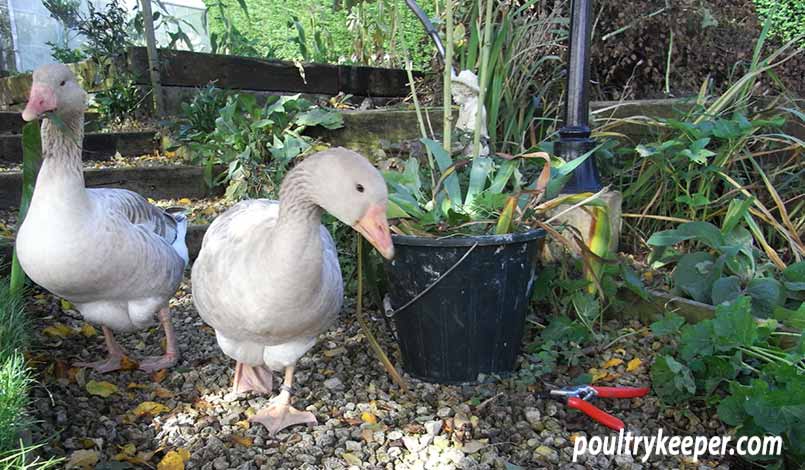
Seeing how smart geese are also makes me think twice about buying products containing real feathers or down. Sadly, much of this down production comes from ‘live plucking’.
Foie Gras production is also something I cannot believe is still allowed in France. I now deliberately avoid shops and restaurants selling Foie Gras when we go to France.
Geese have earned a fierce reputation; however, they will soon be very tame with gentle handling from young and a little hand-feeding.
Water for bathing and drinking
One of the biggest misunderstandings about keeping geese at home is that you need a pond or lake for them, so I wanted to set the record straight in my beginners guide to keeping geese.
Whilst wild geese spend up to ninety per cent of their time on the water and ten per cent of their time on land, it’s the opposite for domestic geese! They spend most of their time on land and very little of it on water.
Note:
Many species of wild geese require substantial sized ponds or lakes that are not covered by this website. The British Waterfowl Association is the best place to find out more about keeping specialist ornamental wildfowl.
Domestic goose breeds are very happy with a plastic tub that’s deep enough to submerge themselves while bathing or mating. A plastic tub can be emptied easily and refilled, making managing their water far easier than keeping a small pond clean.
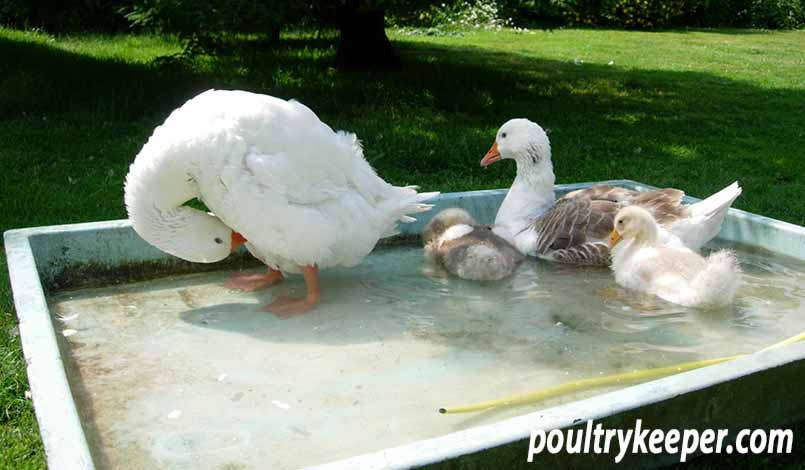
Photo courtesy of Sue and Geoff Chase.
Of course, bathing water can double up as drinking water for geese, providing it’s kept clean. They don’t need water in their house overnight, but water should be available at all other times during the day.
Shallow tubs are the easiest to manage, but the heavier breeds need deeper water to be able to mate successfully.
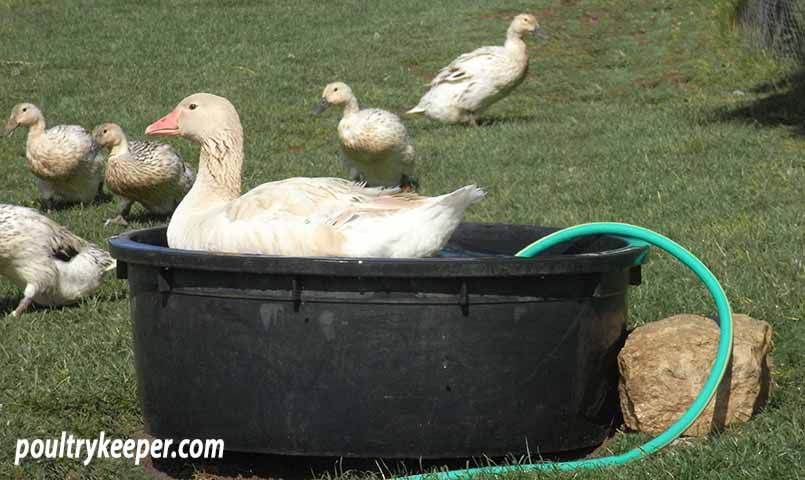
Food
The majority of a goose’s diet is grass. As a general rule of thumb, a quarter of an acre of grass (a reasonably sized lawn in most gardens) would be sufficient to provide a pair of domestic geese with enough grass if you also provide them with other food to eat.
The nutritional value of grass varies throughout the year, and domestic geese, unlike their wild cousins, are heavier and can’t fly off to another field to look for more food, so we need to provide them with wheat and layers pellets as part of their diet.
I provide my geese with wheat in the bottom of a half-sized bucket of water and layers pellets in a hopper. With open feeders, you soon get wild birds and rats coming to feed on your layers pellets, so it might be better to feed them from a hanging feeder inside their house. Wheat left underwater can be left outside. Only the geese can get to it by dipping their heads underwater to reach it.
Geese require insoluble poultry grit and sand to grind down their food. If you have sandy soil, you needn’t provide sand, but it is essential for geese to thrive. It can be normal builders sand which is widely available. Mixed poultry grit is also easy to find online and contains limestone or oyster shell required during the breeding season for strong eggshells.
I have written a guide to feeding geese that goes into more detail on what to feed geese.
Housing for geese
Geese don’t require expensive accommodation with nest boxes or perches, although they need a reasonable size house.
An old garden shed will serve them well, and you can put mesh in place of the windows to give them some ventilation.
You can keep a single pair of medium or large geese comfortably in a shed that has an area of around 2m2. The most common small garden shed size is 6 x 4ft (1.8 x 1.2m) and provides an area of 2.2m2 and would make a good size, with a little extra space if they end up hatching some goslings.
The next most popular size shed is 8 x 6ft (1.8 x 2.4m), giving an area of 4.3m2 and would be big enough to keep 4-5 medium or large-sized geese in.
As for larger housing? It is better to keep domestic geese in small groups, but they can be kept in larger flocks outside of the breeding season. If you are keeping more than five geese (and considering this is a beginners guide to keeping geese), you probably have more experience than me. The most I have kept in a single group is eight.
Housing must be secure against predators. The main one is the fox, of course, but badgers will also kill geese. Badgers are very strong and capable of tearing at planks of wood on poultry houses or weak fencing areas.
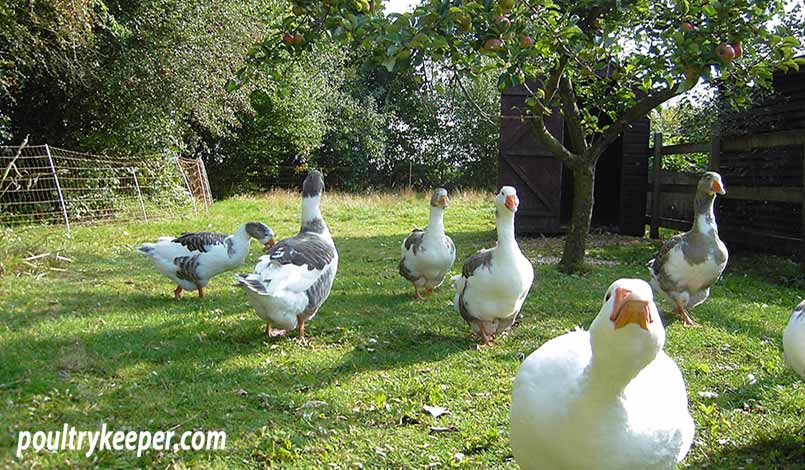
The safest way to keep foxes and badgers away at night is to locate the goose house inside a protected/fenced area. Polecats, Stoats, Weasels, Mink, and Rats can all cause problems for goslings and squeeze through small holes, so ensure ventilation holes are covered with a sturdy mesh.
An orchard is really the perfect place to keep geese (and other poultry for that matter) since they need shade during the summer months, and the grass they feed on will grow well with some dappled shade. Unfortunately, geese will strip young fruit trees of their bark, so you’ll need to protect trunks, but they will do a good job of clearing windfalls as well as keeping the grass trimmed.
How to put geese to bed
Geese will not usually go to bed by themselves at night, but once they know the night-time routine, you can easily herd them into their house with outstretched arms using a command they will get to know such as "bed geese".
Poultry fencing for geese
If you have a secure area (a proven electric fence, for example), you can leave geese and other waterfowl out at night. Unlike chickens and other poultry, waterfowl are active at night and can see reasonably well in the dark.
Keep in mind that geese may make noise at night if they spot something unusual, and when it’s quiet at night, this noise can travel some distance, potentially disturbing sleeping neighbours.
I have always housed my geese at night because I wouldn’t sleep with worry if I heard them making noise because a fox walked past their pen!

Apart from housing, secure poultry fencing is the only big investment you will need to make when keeping geese. I have tried several solutions and found that for large areas, it is better to use electric wires on the outside of the fence to deter climbers (such as mink, stoats or rats) and larger, more common predators such as foxes and badgers who may try to dig under a fence, especially on soft, sandy soils.
The ideal solution would be a tall (say 1.8m) fence with an outward slope on the top and 30cm buried at the bottom. This is type of professional fencing I’ve seen at private waterfowl collections.
The mesh size is too small for smaller predators to squeeze through, and thick enough to prevent badgers or foxes from tearing it. An electric wire would run at low-level to prevent digging and close to the fence at the top to stop climbers from running over the top of the fence.
Keeping Geese:
Breeds and Management
For further reading, I can highly recommend Chris Ashton’s book Keeping Geese: Breeds and Management.
It is my go-to reference book for information about geese.
An invaluable book that’s informative and well-illustrated, covering the goose breeds and all aspects of keeping and breeding domestic geese, suitable for beginners through to experts alike.
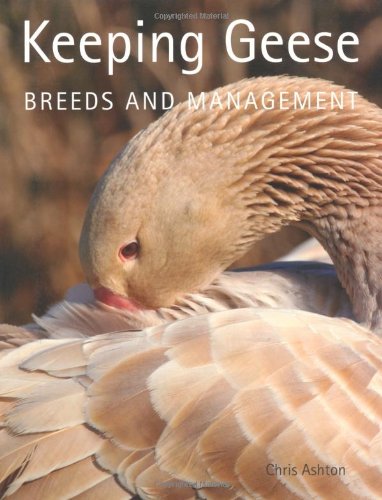
The reality is this solution is costly to have installed, especially over a large area, and I tried to find a compromise. I have used Tundra Otter fencing, 1.6m tall with about 20cm laid flat on the ground around the outside to prevent digging. It has electric wires on the outside to prevent climbing or digging. On internal fences, I have reduced the height to 1.3m, but this is, really, only to keep the birds in their penned areas.
I have written a dedicated guide on poultry fencing to show several fencing examples for poultry, and include fences used over larger areas that are suitable for orchards or fields.
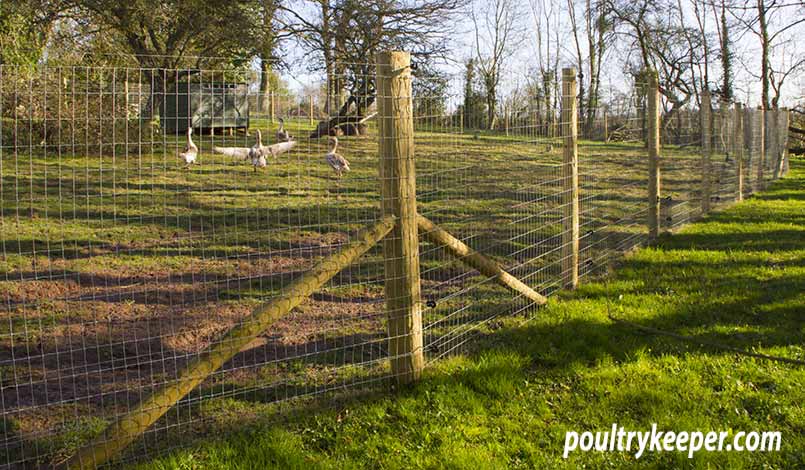
Acquiring geese
There are several interesting breeds of geese, and once you have found one that you like, you will need to start looking for a reputable breeder. Keep in mind (in the UK at least) you may need to plan months in advance because most breeders only have a small number of geese available in the autumn and many will take bookings for these in advance so may not have stock readily available.
Larger poultry shows often have sales pens and you may find a few geese for sale, but one of the best places I have found where you can almost guarantee to find excellent quality stock is at a dedicated waterfowl show. The British Waterfowl Association organises a small number of excellent shows each year.
You may have to travel some distance to reach a good show, but it is always educational speaking with knowledgeable enthusiasts about your chosen breed.
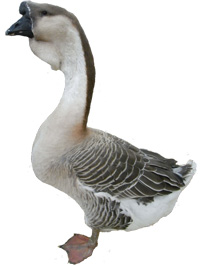
The British Waterfowl Association also maintains a Breeders Directory for members which is useful to track down different breeders.
I have been a member of the British Waterfowl Association for several years. The BWA is an association of enthusiasts interested in keeping, breeding and conserving all kinds of waterfowl — wildfowl, domestic ducks and geese.
They are dedicated to education about waterfowl and their conservation, as well as to raising the standards of keeping and breeding waterfowl.
Membership of the BWA opens up a wide range of services and opportunities to learn about waterfowl. I have made many friends through the BWA and look forward to the quarterly magazine “Waterfowl” packed with interesting news and articles.
The highlight for me, though, is the chance to visit members waterfowl collections on open days.
The BWA welcomes beginners through to experts. Please visit the BWA’s website or contact: secretary@waterfowl.org.uk for further information.





